Ask Adam Anything #4: Time Management Tips
This week, Adam answers a question about how to avoid procrastination and manage the deadlines for multiple projects at once. If you have a question or something you want to share with Adam, post in the comments below! We’ll be back next week with another question answered!
58 thoughts on “Ask Adam Anything #4: Time Management Tips”
Leave a Reply

One Day Builds
Adam Savage’s One Day Builds: Life-Size Velocirapt…
Adam embarks on one of his most ambitious builds yet: fulfil…

Show And Tell
Adam Savage’s King George Costume!
Adam recently completed a build of the royal St. Edwards cro…
All Eyes On Perserverance – This is Only a Test 58…
We get excited for the Perserverance rover Mars landing happening later today in this week's episode. Jeremy finally watches In and Of Itself, we get hyped for The Last of Us casting, and try to deciper the new Chevy Bolt announcements. Plus, Kishore gets a Pelaton and we wrack our brains around reverse engineering the source code to GTA …
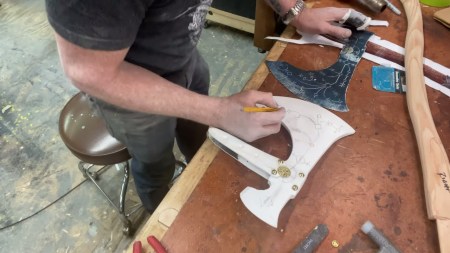
Making
Adam Savage in Real Time: God of War Leviathan Axe…
Viewers often ask to see Adam working in real-time, so this …

One Day Builds
Mandalorian Blaster Prop Replica Kit Assembly!
Adam and Norm assemble a beautifully machined replica prop k…
House of MCU – This is Only a Test 586 – 2/11/21
The gang gets together to recap their favorite bits from this past weekend's Superb Owl, including the new camera tech used for the broadcast and the best chicken wing recipes. Kishore shares tips for streamlining your streaming services, and Will guests this week to dive into the mind-bending implications of the latest WandaVision episod…

One Day Builds
Adam Savage’s One Day Builds: Royal Crown of Engla…
One of the ways Adam has been getting through lockdown has b…

Making
Adam Savage Tests the AIR Active Filtration Helmet…
Adam unboxes and performs a quick test of this novel new hel…

Making
Weta Workshop’s 3D-Printed Giant Eyeballs!
When Adam visited Weta Workshop early last year, he stopped …

One Day Builds
Adam Savage’s One Day Builds: Wire Storage Solutio…
Adam tackles a shop shelf build that he's been putting off f…








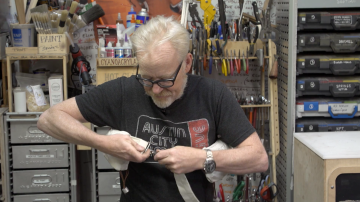
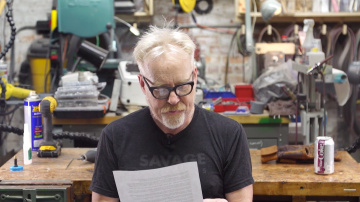


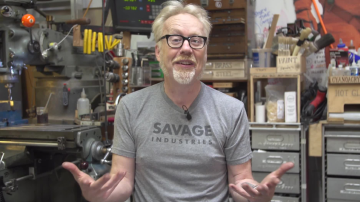
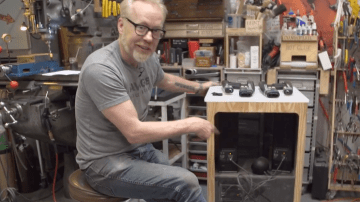
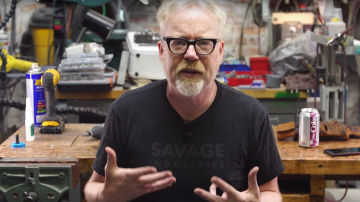
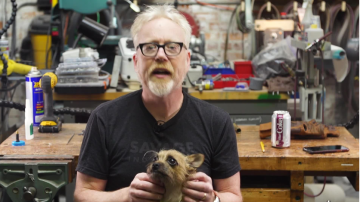


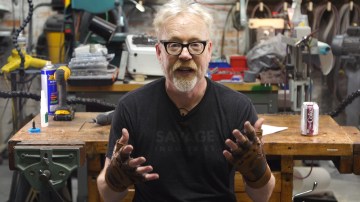







Good morning, Adam. This question is from my brilliant, beautiful, precocious 10 year old daughter, Ellie. I certainly know how I would answer it, but I suspect you’d have a pretty unique and eloquent spin of your own. My daughter has passions and interests that range the entire spectrum. She is a gifted writer, a prolific artist, an enthusiastic athlete and a natural-born scientist. She has so many interests she sometimes feels like she can’t keep up. The question she often asks me as she looks to her own future is this:
Is it possible to be an artist and a scientist at the same time?
Here’s Ellie with her heroes (and her dorky daddy).
hi Adam call me Joe if I know the last name hard to pronounce I need your help levitating an eagle from space 1999 have model I can make make landing pad Abbasid your help to levitate it with magnets or something thank you for listening.
This is a basic time management tool we used in the military. You will often see desks with 4 boxes for this reason. It helped. My 2 cents…
Hi Adam! My name is Nick and I’m a first year computer science at Georgia Tech. I consider myself to be a life-long maker, but ever since I started watching Tested a couple of years ago, my knowledge and abilities have greatly improved thanks to all of the one day builds! However, there’s still one area where I struggle a lot, which is properly translating photo references of props into real world items. I know you just did a video on taking reference shots for the Martian space suit, but I’m wondering how you actually go about using those photos during the build.
Specifically, once you have a reference shot, how do you go about translating that into precise details with exact measurements? Furthermore, how do you do this for shots that come from movie clips, rather than your own personal photos where I assume you would place ruler down for size reference? In general, please just elaborate on some of your techniques for how to actually use reference photos, both personally taken and captured from movie clips.
Hi Adam, long time watcher on youtube and finally signed up for tested premium (would have done it a lot sooner if you guys accepted paypal :P)
Anyway, as a self taught maker who lives in rural Maine, far away from Hollywood and most of the large conventions, do you think there is any hope for finding work as a maker, or am I going to have to move to some big expensive city? Any tips?
Hi Adam,
I have been watching your builds of movie props. and I am curious being that you are in the business/industry and most likely know a lot of people that make the geniune prop. My question is why don’t you go directly to the maker (if still around) and get the details of the parts they used to make that prop vise taking pictures, making drawing etc. Thank you. I love tested.
I am going to try again with a question maby not related to making directly. It is obvious you (Adam) is a busy man, and deeply dedicated to your work. But in a “getting your name out there” phase when it is important to be available and building your name. How do one manage to balance family life with work. It is obvious there are cultural differences between country’s on how to relate and divide time between family and work. But it would be interesting to hear you elaborate on the subject.
//Patric
I have always had a theory/idea that the hard stuff is always hard, so I always do the hard stuff first so that I have to most energy to tackle it.
The checklist Adam mentioned made me think of something that I use to help keep me stay on task, http://www.meistertask.com. We use it in my office and it helps keep me focused. Absolutely wonderful little piece of software!
Hi Adam! How do you learn to overcome failures and learn from them instead of dwelling on them?
When you were building the inventory (in term of standing power tools) of your own shop, which things did you add first and prioritize and how long did it take for you to get all the machines you felt you needed? or is the list still going.
I have a question for Adam I’d love to have answered. I’m an engineer. In engineering, as I assume likewise in model-making, special effects, and myth-busting- there is a lot of team collaboration. I have found that in working in creative groups, some people have a tendency to become very protective of their ideas and sensitive to criticism (good and bad). This often leads to tension and conflict. I am curious of your thoughts on teamwork (both working with teams/being a good person to work), collaboration, and conflict resolution. Thanks!
For anyone who’s curious, this is known as an Eisenhower Matrix, and is a corner stone of many project/time management approaches.
I am a different Adam and have some experience with Mag Lev stuff if you are just looking for general advice I could help you out.
Hey Adam, I’m going to miss the show, I’ve been watching it since I was 9 and I’m 19 now with a house and a job. Thank you for making me want to question everything, try new ideas and build cool stuff in my moms back yard. I’ve spent countless hours trying some of the stuff you guys did on the show. I’ve taped bottle rockets to air planes, made paper hats you could crawl into, and countless other things.
I found a note I stashed in the wall I wrote when in elementary and it said the Mythbusters is my favorite show ever, plus some other stuff. The note was stashed with a hot wheels car. Must have figured I’d need it.
Hope everything goes great now that the show is over.
Sincerely,
Vincent
Hi Adam,
Thanks for a great video, and am looking forward to more and more awesome things from you and Tested!
I have a question about woodworking. Have you ever tried your hand at engraving? Specifically letter carving onto signs or boxes? If so, do you have any tips? And what 1-3 tools would you recommend a beginner start with?
Thanks again!
Adam,
Maybe not a very open ended question, but how do you approach power cable management in your workshop. I have a smaller shed and seem to be constantly winding up and unwinding extension leads as tools come in and out of their storage places, have noticed that in some of your one day builds there are cables across the ground, but wondering if you maybe usually had a smarter solution?
Cheers,
Jordan
Just like to add to this question (since I’m in the early process of building a small scale shop):
Would it be possible to discuss shop infrastructure, and how You personalized your shop’s “guts”.
Thank you for asking a great quest, and hope you don’t mind me tagging along.
Hi Adam,
I try to pose at least one question every time you launch a video like this, just to keep me engaged.
So this time: how do you discover and learn new techniques? i can imagine that if you learn to use eg. a 3D printer that it would take some time (learn the machine AND to draw in 3D). THis time you can’t put in the projects that you’re actually working on. How do you manage this?
If you have a router something like this works well to start with. http://www.leevalley.com/en/wood/page.aspx?p=49305&cat=1,43000,49305
see my post above, wouldn’t let me post directly to you.
I had the same problem. I still use some chords on the floor but I also invested in an extension chord on a recoil and mounted it to the ceiling in the centre of my shop. I use it for most of my tools, keeps the chord up and out of your way whenever it is not in use. Very handy.
I’m looking for a circuit diagram I remember a old pop Electronics magazine they had a circuit use magnets floating a metal sphere on the replace this fear and put the spaceship instead Over The Landing Pad. I’m a little sketchy on electronics the learning so I need to find a link to a schematic or have other ideas on how to make things float thank you for your time if I misspelled anything I’m sorry I have dyslexia.
I am curious how you plan your projects now. I have seen you talk about this a long time ago, saving things in folders on your computer. I have also seen you using Evernote. What tools do you use to flesh out a project and ultimately put those checkboxes you love to have. Thanks!
Thanks for the suggestion! Unfortunately, I don’t have access to a router. I was thinking more along the lines of carving/engraving using chisels.
Hand engraving would be great. You could probably find a relatively inexpensive set of starter wood carving chisels for between $20 & $40 at home depot, craft stores or on amazon. You should post some pictures once you give it a try.
G’day Adam,
A great insight into how you’ve found your working cadence: prioritisation, being focussed, and building velocity. I couldn’t help but imagine a theoretical podcast episode with Merlin Mann http://5by5.tv/b2w and yourself discussing something like this — just a thought… maybe a suggestion 🙂
I can’t express how much I enjoy watching what you do on Tested. Cant wait to see what happens in the future.
Cheers,
Alex.
Hey guys, this is off topic, but was watching the microscope box weathering vid, and the ‘lion box’ was mentioned. Dying to know what that is, or if it was ever discussed or shown. Thanks!
Hi Adam, I know you and tested have covered how to begin making on a low budget before, but do have any tips as to how to start making after you get the materials and tools necessary. I am particularly interested in model making and prop replicating. What do you think would be the best way for me to start making models and replicating props? Possibly getting to point where you of having so much knowledge and experience on those subjects.
Hi Adam ^w^/
I have a couple of questions that kinda go hand in hand;
1) How do you deal with Burnout or Creators Block? It’s sometimes a difficult thing to deal with and I’ve seen it depress a good few of my friends.
2) How do you reign yourself in when you get an over the top idea for something or biting off more than you can chew? I’ve made the mistake of rushing headlong into what I think are fantastic projects because I either get too excited and/or have the illusion that it’s within my bounds …only to crash and burn a short time later…
I’ve learned to deal with little slip ups in the short time I’ve been a maker (Failure is always an option!), but sometimes it’s just too much for someone who dreams big and falls hard when they trip.
(Thank you by the way for getting me into Making, it’s really made my life better and more fun!)
Hey Adam,
I like some of the ways you have solved some of the time wasted looking for things, such as hanging things on wall boards, or your cool mobile tool trolleys.
My question is around setting up a shop for a semi-pro.
I should clarify, I’m a project manager by trade BUT I have many skills from past jobs.
I find making a great stress reliever to the pressure of the daily grind however I am quite time poor. So I’m after some advice around what to invest in that are a balance between time saver tools to be efficient when making as I find myself in the position where I can setup a personal workshop.
EG, i have a standard ratchet wrench set but I see the value in an air compressor and a pneumatic wrench, rivet gun & ratchet etc. Thanks, Scott
My question: you’ve often alluded to the somewhat aloof relationship you had with Jamie on Mythbusters. How do you get the best out of a working relationship where you don’t necessarily get on…and who (no need to name names) has been the biggest d*ck you’ve had to work with?
Hi Adam ,
As a beginner maker trying to build up tooling trying to ensure that the tool you buy is going to be used enough to justify the spend is a problem.
Tools that are required for everyday home use like hand drills etc are not a problem, but when it comes to deciding between sanding disk versus band saw, which is more productive to general prop building ?
Thank you
Brian
Hi Brian, I am not a professional prop maker but I do make a number projects in my own little shop. The budget part when you start collecting tools is a problem that I ran into constantly. In my opinion a good bench top sander, be it belt, disk, spindle or one of the various combination sanders (I have the rigid oscillating belt/spindle sander) can be one of the most important tools you have. They greatly speed up your sanding and can be used to finish off the shapes of anything that you have cut with whatever saw you have. Instead of a band saw you can buy a decent jig saw to get you by until you have enough $ to buy a band saw or scroll saw (plus it takes way less space). I have found that my most used bench/large shop tools are the sander, miter/chop saw and a table saw. That being said a circular saw and a good straight edge can substitute a table saw for a while if needed. Hope that helps a bit.
Thanks for the encouragement! I’ll definitely post some pictures of how it goes.
Would you (or Adam, since this is his Q&A thread) recommend getting those starter chisel sets? I know Adam has talked about some of this stuff before (screwdrivers, I believe) where he recommends getting only the few types of a tool you need, rather than the ‘all in one’ sets? He’s also talked about investing in certain tools rather getting cheap ones.
So I guess the question for Adam (and for the floor) is: are there a specific 1-3 chisels/engraving tools that you would recommend to beginners, and if so, is it worth investing in high quality ones as opposed to a cheap, multi-tool set?
Hi Adam,
2 semi-related questions for you
No questions below, just some comments:
I want to thank you for being who you are: for your philosophies on science, making, education, being a father, being a good human, everything. And to thank you for sharing it with the world — I can’t tell you how grateful I am that I (and the millions of other people) have such open access to your brain. You’ve served as my largest source of inspiration in recent years with Tested and you/Mythbusters were incredibly important in my youth as well. I think you’re an incredible source of good in an often messy world. So thank you. I hope to shake your hand some day, but in the mean time, I hope this will suffice!
Best,
Yosei
thank you for your reply, that does help , I would love to hear everyone’s tool ladder of what to purchase in order with corresponding substitutes while waiting to purchase the big guns .
There was an interesting comment a prop maker I watched some vids of that I thought was good advice for hand tools, he said buy the tool box of tools or cheap package tools , after a while of usage you will see which tools you gravitate to most / use most and then when replacing these key tools spend a bit extra for quality
That is a great question. What I would do in your case is buy a cheap set to start because you don’t really know which of the 5 chisels will give you the desired result. Then once you play with them a bit and get a feel for them you can always replace the one you use the most with a better version. In my opinion $20-$40 to work out the kinks seems reasonable. You could always look at what the set offers, see which one looks like it will give you the desired results and just try to find a chisel that matches. Either option would work, I guess it all depends on if you want to experiment with other types of carving as well or just engraving.
Also, depending on the type of engraving/carving work you want to do the Dremel tools have a number of bit and accessory options that may interest you as well.
Other than the standard screw drivers/pliers/wrenches/hammer I started with:
good jig saw, palm sander, good circular saw (really cheap ones have a tendency to not make a perfect 90 degree cut), 18V or 20V impact driver & variable speed drill, shop Vac
After that I would start upgrading depending on the work and projects you would like to take on. For me I bought a chops saw, mitre saw and bench top sander at the same time. If you find yourself doing lots of finer work that involves screws I find that a nice and light 10.8V drill works really nicely. Then you start getting into compressors, brad nailers, routers and planers. The “tree” for every maker is different depending on their specialty/preferred project.
My suggestions would be to buy the simple power tools you will need for the first couple of projects you want to do then upgrade based on what you feel you need. The things that bug you should be expanded first. My requirements could vary greatly from yours. If you do lots of electronics you will be looking for a better soldering iron etc. Just start small and solve your needs as they arise for you. It won’t take you very long before it starts to become clear what will make your life easier or what tools you will need to add to complete a project. You don’t want to rush out and buy a bunch of expensive tools that may not get lots of use when you are first starting out.
These forms are good for getting advice, if you come up with a question just ask, you will probably get lots of opinions, read them all and then make a decision on what makes the most sense to you (which could be what other people suggest or something totally different)
Excellent
Good question, I also think along with this at what stage of critical mass of info is the decision to begin to physically start building , and also where do you draw the line and say which items to buy from another maker rather than fabricate yourself ?
Hi Adam, you described yourself as a collector of ‘skills’ as well as a collector of things. And this is something I can relate to easily. But what I want to know is what possible skills are you still looking to collect, and once found, how do you go about obtaining (and becoming proficient in) said skill?
Many Thanks
Steve
I have an interesting request but I don’t know if it is possible. I do allot of commuting every week day 100 miles a day and in that time i love to listen to podcasts and audio books. Is there any way you guys could make these Adam answers have a premium podcast outlet as well? it would be awesome I know I would use the crap out of it.
-SB
Question for Adam: As a professional maker (as I am), how do you approach working for someone else in their shop if the tools and materials they provide may not be right for you to do your best work. When do you bring in your own tools and materials to get things done in a way that makes you more happy and/or will impress your employer, and do it without being taken advantage of?
I specifically recall you mentioning that M5’s tablesaw was your tablesaw for years, and your ILM boxes you worked out of were your own tools, for example.
what would be a task that’s considered not important and yet also urgent? like the toilet paper needs to be refilled because we’re all out?
Hey Adam, I have a two-part question. 1. What is your favorite/most versatile and useful tool in your shop. 2. For someone like me, who wants to set up a small personal shop, like in a garage or basement, what do you recommend as a good first power tool for all types of uses and materials. Thanks!
Hi Adam
With the sad demise of mythbusters we no longer have a avenue for revisiting an episode. I have yet another comment for the zombie axe vs gun. My issue is with accuracy. In your calibration tests you made a glancing blow that even at the correct force swing would not have been a kill. You did not take this into account with your test. It would be interesting to see your initial accuracy plus how accuracy diminishes as you tire. Also with the chainsaw you did not take into account mechanical failure such as jams, in the skull, fuel run time and other issues that could arise.
Still loved the episode and looking forward to seeing your continuing and new endeavours here.
Sad I missed Jaime and you on tour in Australia. Any chance we will see you again.
Thanks
Barry Williams
Hi Adam, I just saw a older episode of Mythbusters and I have a question. Has your methodology on working in a shop changed from the time you started Mythbusters to now. Why I ask is because it seemed in the early years of the show they liked the play up the fact you were this care free spirit when it came to projects and use of tools at M5 and Jamie was always mad at you for making some kind of mess or nearly breaking a tool. This way of working doesn’t really match up with how your shop is set up and how you work on a project (based on Tested videos and interviews). Were you really that carefree 15-20 years ago and have developed a more refined shop methodology or have you had roughly the same methodology but just was playing up the goofy/carefree for good TV?. Thanks for your time.
Daniel
Hi Adam, My name is Chris and I’m a backstage manager for a cruise liner. I’ve been a big fan if Mythbusters since its first episode. I did notice that some of the episodes require to build/assemble items on-site away from the shop.
My questions what is the best way to travel with tools and any logistic tips if a kit needs to be shipped?
Part of my job is to travel from home to a ship port (sometimes not in the same place) and work on a ship for 6-10 months then go back home for vacation. I do have to have a fairly decent amount of tools since not all ships are equipped the same.
Do you have to choose?
From watching a few of these videos I’ve gleaned that your a prop maker, art director, (previously?) a graphic designer, a television personality and probably much more. I would love to be a writer/director/art director/prop maker but I feel I need to choose one. And I find while building on a reputation as one (ie prop maker) my reputation as the other (lets say art director) wanes.
Is it worth it to decline the jobs that make you a reputation as something else (set dresser for example)?
Have you experienced this?
Could you provide any sagely advice?
Merci Buckets,
Seamus
Hey Tested Team! Thank for posting this one. I just used the “do the hardest part first” approach on a website project for a client, and it made the rest of the items on the list a breeze. It’s great advice for projects that are semi-annoying. Thanks again!
I use Asana (asana.com) for doing the checklist breakdown and it works very much the same way. I do use paper and pencil on my desk for a daily To Do, then I get to check check check things off my asana list at the end of the day (and my boss and team members can see it).
You might want to add more information to this. The method you illustrate is attributed to Gen. Dwight Eisenhower (who planned D-Day). It was recently popularized by Stephen Covey. The basic idea is that once you categorize your tasks by Importance and Urgency into the four quadrants you then schedule the tasks as follows:
Quadrent 4 (Not Important & Not Urgent) – Don’t bother with them at all.
Quadrent 1 (Important and Urgent) – Don’t bother much about these … since they are Important and Urgent they will be screaming for attention.
Quadrent 3 (Not Important and Urgent) – Here again, these things tend to take care of themselves. Urgent items usually do. So once again, there is not much need to focus on them.
Quadrent 2 (Important and Not Urgent) – This is the area you focus on the most. The reason is that since these are low urgency they get overlooked, but they are also the very Important things that you really ought to be addressing. Typically these things are long term goals: write a novel, learn a new language, spend an hour a day reading. Since there is no urgency they get overlooked.
Look for a video here where Adam and a couple of other guys discuss a basic ($100, IIRC) beginner tool kit. The short answer is that a lot of it depends on what area you are working in. Electronics demands different tools than woodworking or metal working or sculpting or painting.). Adam’s video on this is really very good.
Excellent
Merci beaucoup
Jean-Luc
Excellent
Merci beaucoup
Jean-Luc